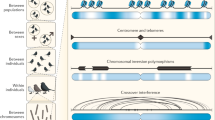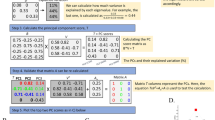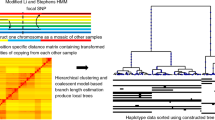Key Points
-
The X chromosome is unique as a population-genetics tool because it combines the desirable features of other commonly used genetic markers: it recombines and has a deep history, similar to the autosomes; and it has accessible haplotypes and a sex-biased mode of inheritance, similar to mtDNA and the Y chromosome.
-
Haplotype-based phylogenetic studies of the X chromosome, among others that have used this chromosome, have contributed greatly to the debate between the Out of Africa and multiregional models of the origin of modern humans.
-
So far, the X chromosome has made almost no contribution to finer-scale historical studies, which are dominated by mtDNA and the Y chromosome. Its potential for contributing to these studies is great, however, because of the independent historical records that are preserved by different loci on this chromosome.
-
The X chromosome probably contains hundreds of independent loci, each informative enough to allow detailed historical studies without the complications that are created by an excessive amount of recombination.
-
Comparisons of X and Y chromosomes, and autosomes are the basis for the continuing study of differences between male and female mutation rates.
-
Linkage disequilibrium on the X chromosome will provide the only practical route to understanding differences between male and female recombination patterns.
-
Comparison of the X chromosome and autosomes might contribute significantly to understanding a complex set of anthropological and historical questions about the different roles of males and females in human history.
Abstract
Genetic variation records a large amount of information about the history of a species and about the processes that create and shape that variation. Owing to the way in which it is inherited, the X chromosome is a rich resource of easily accessible genetic data, and therefore provides a unique tool for population-genetic studies. The potential of the human X chromosome, which rivals that of the more traditional mtDNA and Y chromosome, has only just begun to be tapped.
This is a preview of subscription content, access via your institution
Access options
Subscribe to this journal
Receive 12 print issues and online access
$189.00 per year
only $15.75 per issue
Buy this article
- Purchase on Springer Link
- Instant access to full article PDF
Prices may be subject to local taxes which are calculated during checkout

Similar content being viewed by others
References
Cann, R. L., Stoneking, M. & Wilson, A. C. Mitochondrial DNA and human evolution. Nature 325, 31–36 (1987).
Lucotte, G., Guerin, P., Halle, L., Loirat, F. & Hazout, S. Y chromosome DNA polymorphisms in two African populations. Am. J. Hum. Genet. 45, 16–20 (1989).
Hey, J. Mitochondrial and nuclear genes present conflicting portraits of human origins. Mol. Biol. Evol. 14, 166–172 (1997).
Zietkiewicz, E. et al. Nuclear DNA diversity in worldwide distributed human populations. Gene 205, 161–171 (1997).
Zietkiewicz, E. et al. Genetic structure of the ancestral population of modern humans. J. Mol. Evol. 47, 146–155 (1998). An early summary-statistic study of a human X-chromosome locus (8 kb of intronic sequence in the dystrophin gene). It is distinguished by the very large data samples that were used (250 chromosomes were used for SNP ascertainment and 860 chromosomes were genotyped).
Nachman, M. W., Bauer, V. L., Crowell, S. L. & Aquadro, C. F. DNA variability and recombination rates at X-linked loci in humans. Genetics 150, 1133–1141 (1998). A study of diversity at seven X-chromosome loci in humans that focuses on evidence for natural selection.
Jaruzelska, J. et al. Spatial and temporal distribution of the neutral polymorphisms in the last ZFX intron: analysis of the haplotype structure and genealogy. Genetics 152, 1091–1101 (1999). An early haplotype-based study of a human X-chromosome locus (1.1 kb) that supported a classic Out of Africa model of human migration.
Harris, E. E. & Hey, J. X chromosome evidence for ancient human histories. Proc. Natl Acad. Sci. USA 96, 3320–3324 (1999). A study of haplotypes in a 4.2-kb X-chromosome locus, showing surprisingly large differences in variation between African and non-African human populations.
Kaessmann, H., Heissig, F., von Haeseler, A. & Pääbo, S. DNA sequence variation in a non-coding region of low recombination on the human X chromosome. Nature Genet. 22, 78–81 (1999). An important haplotype study that analysed a 10-kb non-coding region on the human X chromosome.
Lahn, B. T. & Page, D. C. Four evolutionary strata on the human Y chromosome. Science 286, 964–967 (1999).
May, C. A., Shone, A. C., Kalaydjieva, L., Sajantila, A. & Jeffreys, A. J. Crossover clustering and rapid decay of linkage disequilibrium in the Xp/Yp pseudoautosomal gene SHOX. Nature Genet. 31, 272–275 (2002).
Skaletsky, H. et al. The male-specific region of the human Y chromosome: a mosaic of discrete sequence classes. Nature 423, 825–837 (2003).
Jobling, M. A. & Tyler-Smith, C. The human Y chromosome: an evolutionary marker comes of age. Nature Rev. Genet. 4, 598–612 (2003). A recent comprehensive review of the Y chromosome.
Waterston, R. H. et al. Initial sequencing and comparative analysis of the mouse genome. Nature 420, 520–562 (2002).
Venter, J. C. et al. The Sequence of the Human Genome. Science 291, 1304–1351 (2001).
International Human Genome Sequencing Consortium. Initial sequencing and analysis of the human genome. Nature 409, 860–921 (2001).
Bohossian, H. B., Skaletsky, H. & Page, D. C. Unexpectedly similar rates of nucleotide substitution found in male and female hominids. Nature 406, 622–625 (2000).
Li, W. H., Yi, S. & Makova, K. Male-driven evolution. Curr. Opin. Genet. Dev. 12, 650–656 (2002). A report that summarizes many of the issues involved in estimating male and female mutation rates.
Makova, K. D. & Li, W. H. Strong male-driven evolution of DNA sequences in humans and apes. Nature 416, 624–626 (2002).
Ebersberger, I., Metzler, D., Schwarz, C. & Pääbo, S. Genomewide comparison of DNA sequences between humans and chimpanzees. Am. J. Hum. Genet. 70, 1490–1497 (2002). A comprehensive study of genetic divergence between humans and chimpanzees, using autosomes and sex chromosomes.
Kong, A. et al. A high-resolution recombination map of the human genome. Nature Genet. 31, 241–247 (2002).
Lin, S., Cutler, D. J., Zwick, M. E. & Chakravarti, A. Haplotype inference in random population samples. Am. J. Hum. Genet. 71, 1129–1137 (2002).
Stephens, J. C. et al. Haplotype variation and linkage disequilibrium in 313 human genes. Science 293, 489–493 (2001).
Anagnostopoulos, T., Green, P. M., Rowley, G., Lewis, C. M. & Giannelli, F. DNA variation in a 5-Mb region of the X chromosome and estimates of sex-specific/type-specific mutation rates. Am. J. Hum. Genet. 64, 508–517 (1999). A summary-statistic study that focuses on differing mutation rates between the sexes.
Huang, W. et al. Sex differences in mutation rate in higher primates estimated from AMG intron sequences. J. Mol. Evol. 44, 463–465 (1997).
Lawson, L. J. & Hewitt, G. M. Comparison of substitution rates in ZFX and ZFY introns of sheep and goat related species supports the hypothesis of male-biased mutation rates. J. Mol. Evol. 54, 54–61 (2002).
Chang, B. H et al. Weak male-driven molecular evolution in rodents. Proc. Natl Acad. Sci. USA 18, 827–831 (1994).
Chang, B. H. & Li, W. H. Estimating the intensity of male-driven evolution in rodents by using X-linked and Y-linked Ube 1 genes and pseudogenes. J. Mol. Evol. 40, 70–77 (1995).
McVean, G. T. & Hurst, L. D. Evidence for a selectively favourable reduction in the mutation rate of the X chromosome. Nature 386, 388–392 (1997).
Hubert, R., MacDonald, M., Gusella, J. & Arnheim, N. High resolution localization of recombination hot spots using sperm typing. Nature Genet. 7, 420–424 (1994).
Jeffreys, A. J., Ritchie, A. & Neumann, R. High resolution analysis of haplotype diversity and meiotic crossover in the human TAP2 recombination hotspot. Hum. Mol. Genet. 9, 725–733 (2000).
Jeffreys, A. J., Kauppi, L. & Neumann, R. Intensely punctuate meiotic recombination in the class II region of the major histocompatibility complex. Nature Genet. 29, 217–222 (2001).
Schneider, J. A., Peto, T. E., Boone, R. A., Boyce, A. J. & Clegg, J. B. Direct measurement of the male recombination fraction in the human β-globin hot spot. Hum. Mol. Genet. 11, 207–215 (2002).
Ruwende, C. & Hill, A. Glucose-6-phosphate dehydrogenase deficiency and malaria. J. Mol. Med. 76, 581–588 (1998).
Sabeti, P. C. et al. Detecting recent positive selection in the human genome from haplotype structure. Nature 419, 832–837 (2002).
Charlesworth, B., Morgan, M. T. & Charlesworth, D. The effect of deleterious mutations on neutral molecular variation. Genetics 134, 1289–1303 (1993).
Nordborg, M., Charlesworth, B. & Charlesworth, D. The effect of recombination on background selection. Genet. Res. 67, 159–174 (1996).
Lercher, M. J. & Hurst, L. D. Human SNP variability and mutation rate are higher in regions of high recombination. Trends. Genet. 18, 337–340 (2002).
Hellmann, I., Ebersberger, I., Ptak, S. E., Pääbo, S. & Przeworski, M. A neutral explanation for the correlation of diversity with recombination rates in humans. Am. J. Hum. Genet. 72, 1527–1535 (2003).
Payseur, B. A., Cutter, A. D. & Nachman, M. W. Searching for evidence of positive selection in the human genome using patterns of microsatellite variability. Mol. Biol. Evol. 19, 1143–1153 (2002). A broad search for evidence of selection in the human genome that includes differences in selection between the X chromosome and the autosomes.
Nachman, M. W. Single nucleotide polymorphisms and recombination rate in humans. Trends Genet. 17, 481–485 (2001).
Sachidanandam, R. et al. A map of human genome sequence variation containing 1.42 million single nucleotide polymorphisms. Nature 409, 928–933 (2001).
Begun, D. J. & Whitley, P. Reduced X-linked nucleotide polymorphism in Drosophila simulans. Proc. Natl Acad. Sci. USA 97, 5960–5965 (2000).
Yu, N. et al. DNA Polymorphism in a worldwide sample of human X chromosomes. Mol. Biol. Evol. 19, 2131–2141 (2002). A large haplotype-based study of a 10-kb region on the X chromosome that indicates a multiregional model of human origins.
Seielstad, M. T., Minch, E. & Cavalli-Sforza, L. L. Genetic evidence for a higher female migration rate in humans. Nature Genet. 20, 278–280 (1998).
Oota, H., Settheetham-Ishida, W., Tiwawech, D., Ishida, T. & Stoneking, M. Human mtDNA and Y-chromosome variation is correlated with matrilocal versus patrilocal residence. Nature Genet. 29, 20–21 (2001).
Laporte, V. & Charlesworth, B. Effective population size and population subdivision in demographically structured populations. Genetics 162, 501–519 (2002).
Oota, H. et al. Extreme mtDNA homogeneity in continental Asian populations. Am. J. Phys. Anthropol. 118, 146–153 (2002).
Pennisi, E. Tracking the sexes by their genes. Science 291, 1733–1734 (2001).
Harding, R. M. et al. Archaic African and Asian lineages in the genetic ancestry of modern humans. Am. J. Hum. Genet. 60, 772–789 (1997).
Rana, B. K. et al. High polymorphism at the human melanocortin 1 receptor locus. Genetics 151, 1547–1557 (1999).
Jin, L. et al. Distribution of haplotypes from a chromosome 21 region distinguishes multiple prehistoric human migrations. Proc. Natl Acad. Sci. USA 96, 3796–3800 (1999).
Rogers, E. J. et al. Integrated analysis of sequence evolution and population history using hypervariable compound haplotypes. Hum. Mol. Genet. 9, 2675–2681 (2000).
Yu, N. & Li, W. H. No fixed nucleotide difference between Africans and Non Africans at the pyruvate dehydrogenase e1 α-subunit locus. Genetics 155, 1481–1483 (2000).
Gabriel, S. B. et al. The structure of haplotype blocks in the human genome. Science 296, 2225–2229 (2002).
Yu, N. et al. Larger genetic differences within Africans than between Africans and Eurasians. Genetics 161, 269–274 (2002). A summary of a large amount of data on genetic variation within and between human populations.
Miller, R. D., Taillon-Miller, P. & Kwok, P. Y. Regions of low single-nucleotide polymorphism incidence in human and orangutan Xq: deserts and recent coalescences. Genomics 71, 78–88 (2001).
Takahata, N., Lee, S. H. & Satta, Y. Testing multiregionality of modern human origins. Mol. Biol. Evol. 18, 172–183 (2001).
Anderson, S. et al. Sequence and organization of the human mitochondrial genome. Nature 290, 457–465 (1981).
Heyer, E. et al. Phylogenetic and familial estimates of mitochondrial substitution rates: study of control region mutations in deep-rooting pedigrees. Am. J. Hum. Genet. 69, 1113–1126 (2001).
Nachman, M. W. & Crowell, S. L. Estimate of the mutation rate per nucleotide in humans. Genetics 156, 297–304 (2000).
Ingman, M., Kaessmann, H., Pääbo, S. & Gyllensten, U. Mitochondrial genome variation and the origin of modern humans. Nature 408, 708–713 (2000).
Acknowledgements
I wish to thank D. Reich, M. Daly and two anonymous reviewers for helpful comments on the manuscript, and G. Thorisson for providing remapped TSC data.
Author information
Authors and Affiliations
Ethics declarations
Competing interests
The author declares no competing financial interests.
Related links
Glossary
- PHYLOGENETIC TREE
-
A graph that depicts the ancestor–descendant relationships between organisms or gene sequences. The sequences are the tips of the tree. Branches of the tree connect the tips to their (unobservable) ancestral sequences.
- MICROSATELLITE
-
A class of repetitive DNA that is made up of repeats that are 2 to 8 nucleotides in length. They can be highly polymorphic and are frequently used as molecular markers in population-genetic studies.
- LINKAGE DISEQUILIBRIUM
-
A nonrandom correlation between alleles of physically linked loci.
- SYNTENY
-
Collinearity in the order of genes (or of other DNA sequences) in a chromosomal region of two species.
- EFFECTIVE POPULATION SIZE
-
(Ne). The size of the ideal population in which the effects of random drift would be the same as those seen in the actual population.
- HETEROZYGOSITY
-
A measure of the genetic variation in a population: the mean number of differences found when comparing two copies of a sequence. Usually expressed as the number of differences per base pair.
- THE SNP CONSORTIUM
-
(TSC). A public–private effort that mapped approximately 1 million SNPs across the human genome.
- POPULATION STRUCTURE
-
A departure from random mating as a consequence of factors such as inbreeding, overlapping generations, finite population size and geographical subdivision.
- GENETIC DISTANCE
-
The degree of genetic differentiation between two populations. It is measured by comparing allele frequencies (and in the case of microsatellite markers, by comparing allele sizes) between populations.
- OUT OF AFRICA MODELS
-
Models for the origin of modern human populations in which anatomically modern Homo sapiens evolved ∼100,000–150,000 years ago in Africa and expanded from there to the rest of the world.
- BOTTLENECK
-
A marked reduction in population size followed by the survival and expansion of a small random sample of the original population.
- SELECTIVE SWEEP
-
The process by which new, favourable mutations become fixed so quickly that physically linked alleles also become fixed by 'hitchhiking'.
- SUMMARY STATISTIC
-
A single number that summarizes complex data; examples include mean and variance.
- MULTIREGIONAL MODELS
-
Models for the origin of modern human populations in which anatomically modern Homo sapiens evolved simultaneously throughout Africa, Europe and Asia.
- PATRILOCALITY
-
A residential pattern in which a married couple settles in the husband's home or community.
Rights and permissions
About this article
Cite this article
Schaffner, S. The X chromosome in population genetics. Nat Rev Genet 5, 43–51 (2004). https://doi.org/10.1038/nrg1247
Issue Date:
DOI: https://doi.org/10.1038/nrg1247
This article is cited by
-
Effects of genomic homozygosity on total fitness in an invertebrate: lethal equivalent estimates for Drosophila melanogaster
Conservation Genetics (2023)
-
Population structure of threatened caribou in western Canada inferred from genome-wide SNP data
Conservation Genetics (2022)
-
Ancestral genetic legacy of the extant population of Argentina as predicted by autosomal and X-chromosomal DIPs
Molecular Genetics and Genomics (2021)
-
Exploring the Western Mediterranean through X-chromosome
International Journal of Legal Medicine (2021)
-
Theoretical and empirical comparisons of expected and realized relationships for the X-chromosome
Genetics Selection Evolution (2020)



